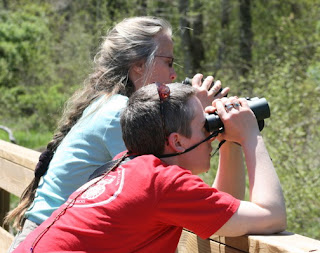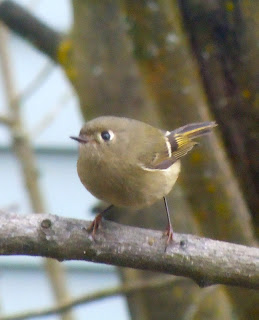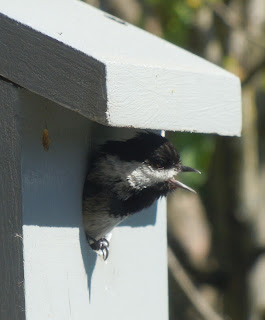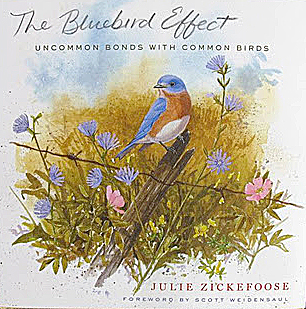Most people look at birds with a hazy benevolence. They appreciate the robins and cardinals for being recognizable and they wish the other birds would announce themselves too, but unfortunately they remain brown and indistinct and hidden in the shrubbery. Some birds will helpfully tell you who they are, like the chickadee, but others, like the red-winged blackbird (“pull on my PEE-ter!”) will not. It takes a birder to sort them out.
 |
| Me and Kelly, 2010 |
And most people have nothing against birders, but think, somehow, that their obsession is sort of trivial and dorky. But the only thing keeping most people from being bird dorks is the ability to see the birds. I once witnessed the transformation myself. I met my friend Kelly at the New River Birding And Nature Festival, true, and so I assumed she was fond of birds, but it was not a fully fledged fondness at first. Mostly she had a fondness for her wife Sara. (Everyone does.) We were both on the introductory field trip, and the guide had pointed out a beige flittiness in the branches above. And then he instructed us to–pay attention here–keep looking at the flitty area while bringing the binoculars up to our eyes. Well! I’d only been using binos for fifty years at that point without having that particular piece of information. It should be obvious, but many people, such as myself and Kelly, locate movement in the treetops and then look down to make sure we get the binoculars on our eyes and then look back kup to scan the tree with them, trying to find the movement again, to no avail. It’s like shooting the Hubble telescope into space with a wobble built in and hoping a nova will sail into view.
 |
| A Cuteness Bomb |
So it turns out that people of ordinary intellect can indeed lift binoculars in place without missing or stabbing themselves in the eyeballs with them, and then what do they see? Why, they see cuteness bombs going off all over the canopy. The flitty thing resolves into a blue-gray gnatcatcher pasting together a teacup nest out of lichens and nearby is a by-God tufted titmouse with a perky tiara and an orangey spot on the side and a black nose and a button beak and way over there is a mossy pendulous nest like a giant green scrotum and just like that Kelly and I are birders, complete with squeaky noises and zeal. Kelly instantly began rabbiting around the landscape like there was a whole skyful of news and she was behind in her reading. Fly as they might, those birds were not going to escape her and her newly useful binoculars. All it takes is noticing, and all that takes is binoculars and, for people without a grasp of the obvious, a sensible lesson in using them.
Once I’d come back home an accomplished noticer, Dave set up a bird resort right outside my writing room. There was a chickadee house, a suet feeder, and a hummingbird feeder within a yard of the window, and now, instead of staring into space while not writing, I could look at birds while not writing. I got regular visits from jays, a flicker, a gang of bushtits, and hummers that will happily kick every one of their asses for them. Two chickadees started hanging out a lot. They looked identical, but now I was a noticer. One of them, Studley, had a lower voice and seemed a little more aggressive, tidying up the suet feeder by scraping bushtits off it. Studley and Marge began bringing grass to the house and dumping it inside. (I learned later that they were making a mattress.) One day Marge wouldn’t leave Studley alone and finally caught up to him and did something to his rear end that I would never have expected of Marge, and went a long way toward explaining why they never answered to their names. It only took a few seconds and then Studley retired to the house and a couple weeks later both Marge and Studley were hauling in grubs and bugs at the rate of 500,000 a day and evidently they made baby birds out of them, because that was the next thing that came out.
That’s all a birder is. A noticer. The more you notice, the more you care. The more you care, the more you love. The more you love, the happier you are. My gratitude goes out to Jeff Gordon, the president of the American Birding Association, for showing Kelly and me how to spot birds with our binoculars, and waiting until we were out of earshot before laughing at us. Try it yourself. Because the little feathered buggers are everywhere, zipping all over the planet like valentines from God, and most of us are acting like we’ve got more important mail coming. But we don’t.
My friend Julie Zickefoose is a virtuoso noticer and the proprietor of eighty acres of bird joy on the hem of Ohio. If you want to see how happy you can get just by paying attention, have a look at her luscious new book, The Bluebird Effect: Uncommon Bonds With Common Birds. You’ll be plumb inspired.



That binocular trick : so THAT'S how they do it. Thank you, thank you, thank you, and a big " duh", while I'm at it.
I'm so glad it wasn't just me and Kelly.
It wasn't just you, Kelly and sarah, either. I think I'm going to be able to see our birds much more easily now… =bowing many many many thanks!= I wonder if my husband, who loves his binoculars like a seeing eye dog and I never understood why, will start to lag behind *me in spotting now. Oh, I hope, I hope!! I really am not going to give him this tip for at least a couple hours into our next adventure! 🙂
He already knows it. Remember, you have to see the flittiness first and then do the trick. You go.
I think you are a genius! I will try that with my binos next time I'm out watching birds. It seems obvious, but it's not. How often I've searched the skies with the binos looking for that bird out there somewhere. I'll check out her book, Murr, since I love my birdies, too.
A real genius wouldn't have to be shown how to use binoculars, I'm thinking.
That's all a birder is… (I adore that paragraph.)
Well I adore you.
Beautiful…I love the birds and spend many happy hours watching them flit around the feeders and bird bath….you should try putting out some soap on a rope and dish of water for them..lots of fun.
Soap? Really? Will I see them scrubbing their little wingpits?
Soap? Really?
I know that binocular trick but forget to tell people about it when leading birding tours. Thanks. And maybe chickadees do it backwards. Defniitely snortworthy.
Gotta go and find birds for our visitors to see.
Another thing is there are very few binoculars that work for me because my eyes are so close together they damn near share a tear duct. Like "Cathy," only smaller and with fewer lashes.
Eyes-too-close-together? Isn't that a diagnostic marker in the DSM-V? [smile]
Nonetheless, am I being pompous or daft when I bring up the hinge between the left and right lenses? You muscle it with one hand clasped around each to adjust the width for your freakishly close eyes. (Well, it is there on the higher-end models.)
Once an Unc showed me that trick, I was able to see the light!
I think "Bushtits and Hummers" would be a great name for a band.
Totally cracked up at Studley and Marge.
"Studley and Marge" would be a great name for a band.
"Valentines from God" – love that!
But I think maybe there are people who like to be noticers and people who don't. I can see plenty of birds from my living room window, and they are very nice; but it doesn't make me want to get up at the crack of dawn and start tramping around the woods with a pair of binoculars.
Just count me among the unenlightened…
I'm not crazy about the crack of dawn part either. So I see fewer birds, and try to notice the hell out of them.
Lovely.
Also, I got stuck, in a good way, on "writing room." Yay for you to have a room with that name!
I need a room with nobody else in it. That's all it is.
I have to be more careful with binoculars now that my eyebrows are more like awnings.
Can you comb over the binoculars?
I learned the binocular skill of bringing them to your eyes without losing the target standing lookout watch on a US Navy Destroyer in 1959. I have never thought to pass it on to someone else and shame on me. I will fix that.
We are not "birders" here however at this time of year there is an explosion of birds here so at cocktails, teatime or the hour to drink adult beverages, or whatever you wish to call it, we observe the birds in the garden and the surrounding sky. You have given us a label that fits and that is "Noticers". I think it fits us quite well.
Here in SE Louisiana there are plenty to notice.
We both know what you are. If you feel better calling yourself a noticer, you just go ahead on!
No Double-breasted Mattress Thrashers? Okay. Okay. It's an old joke. Older than me even. I'm a late arrival to the bird-watching party, but since I moved here, where there's a big feeder right outside my kitchen window, I'm forever running to the bird book and interrupting phone calls with exclamations of happy over a new arrival at the feeder. Indigo bunting pair last year, but they're no-shows this year, so far. I hold out hope…. My question is: when did I become my grandmother?
Julie's book looks interesting. I'll check it out. I agree. We don't have more important mail. It's fun, being a noticer.
You only get to be your grandmother if you're lucky and really, really good. Indigo buntings! I've never seen one.
My sister is a birder in her own yard in Calgary. she has feeders set up and has learned to identify a great many of her visitors. Her trick is taking great photographs and posting them on FB. She is just getting into videos. We have a few songbirds here I have never seen but wish I knew their names.
Someone told me to learn one a month–the song and everything. And eventually you're in'em.
Thanks for the tip about binoculars — so obvious when you know! Did you know that 'birders' in the UK are called 'twitchers'?
You must tell me why.
The most wonderful thing since the invention of binoculars is image-stabilization binoculars. I have a hand tremor that makes looking through binoculars an adventure in seasickness, but the image-stabilizers are fabulous. Press and hold the button, and the whole field of view settles down. They make it a joy to watch birds, and also make it possible to watch them easily at much greater distances than regular binoculars.
A big flock of trumpeter swans flew over our place in Calgary last week, heading north. Maybe spring is on its way at last.
I tried those binoculars! They're amazing. But if I had one more thing that needed its battery recharged, nothing would get done. Swan on.
OMG — that's EXACTLY what a red-winged blackbird says! Lovely post, and thanks for the bino
Meant to say "thanks for the bino tip, but somehow it didn't work…
A lot of my thoughts peter out in the middle so I just thought that's what happened to you.
I Thank You for "Valentines from God" so so true…
And it would be rude to refuse a Valentine, no?
wonderful post – I love how it explains what birders are: "noticers". How true. Thanks for making me smile.
You're welcome, Beth!
I love this post! It makes me want to go out and do some noticing.
I have but a mild affection for the post, much as I have for the bird outside my window, one of may occasional residents of my attic that come and go as they choose due to a small aperture that is clearly marked "no birds allowed."
Our sign says "No Loud Birds." It doesn't work either, during crow nesting season.
Love this post.
🙂
"Pull on my PEE-ter"? We have red-winged blackbirds in my region, and their call sounds more like a guttural "ooonka-REEEEEE!" Do different subspecies make different sounds?
The community garden I frequent is a popular hangout for killdeer, who are not only cute beyond measure but have a sweet song as well.
No, Ahab. It depends on what mood they're in. Or maybe they're just not that into you.
I'm not a serious bird watcher but I notice that no matter how gloomy I am, I feel more cheerful after watching and listening to birds.
You've discovered Gloom-Be-Gone. Take liberally.
Birds are an obsession here. I cannot count the hours we spend looking at them. Always a joy. The ones that move too fast to identify? Little Brown Jobs (LBJs).
We have lots and lots of Lyndon Baineses. Herds of them.
I just went to my second-favorite app, iBirdPro, to check the sound of the red-winged blackbird. It sounds more like konk-a-ree to me, but your version certainly makes me want to listen for it in nature! I only learned that binoc trick last year but it sure makes a difference. Thanks for this (yet another) great post.
That's the family-friendly version of the app.
Love the birds…and once you begin to notice them, you start to notice so many other things as well.
And THAT'S the thing, right there. Right on chlostypants.
"Because the little feathered buggers are everywhere, zipping all over the planet like valentines from God, and most of us are acting like we've got more important mail coming. But we don't."
The most profound statement I have read in a while. It is a poem, a song, a sonnet waiting for you to finish it. When you do, send it to all of us (as if we could stop you).
Birds are mood-lifters, with no evil side effects, except for the occasional
accident on my table. I've noticed bluebirds appear when I most need to see one. How attuned are those little guys?
That's right! Just try to stop me! Thank you. I don't have bluebirds. I'm in Ohio now getting my fill.
So true, Murr and Shaatzie- Virginia has LOADS of bluebirds who stay in our backyards year-round. Reason enough to live here, not to discount the goldfinches, 4 kinds of woodpeckers and the wren who serenades us every morning. We keep the binos by the kitchen table for fast visitors….
Murr, thank you for this funny and informative post. I suck with the binoculars, so I just watch what shows up at my feeder, because I can't find anything through the lenses, maybe because those little birdies don't stay still for me. I can't wait to try your trick.
I love what you wrote: The more you notice, the more you care. The more you care, the more you love. The more you love, the happier you are. Exactly.
I may not be a great birder but I'm a really good noticer. I'm going to see if I can notice some new birds this spring. Have you started keeping a list yet, or marking the birds you've seen in your bird book? That's when you know you've crossed a line.
You know? I haven't. For one thing as soon as I get a life bird I forget it so I can get it again later. I'm ditzy. I have a life list of birders longer than my life list of birds. Do try that trick.
I never knew that trick with the binoculars! I am always watching for birds and listening to them. They always sound so happy. I bet Pat L. is good at identifying birds. Me, I just point and say, "Look! A brownish bird." (or a bird with red spot, or a bird with yellow, etc. You get the idea!)
I have the same method for identifying trees…all trees!
You know, sometimes they sound downright pissed. But that's fun too.
Ah! Wonderful. Now that you've explained it all I don't feel quite so dorky with my newfound hobby. Nor find it necessary to refer my macho male friends back to the days when, with dog afield, I used to shoot some of the larger birds out of the sky with my 12 gauge shotgun….
It's okay to feel dorky and still do it. Dorks rule.
I am a noticer too, but the birds I watch would be more of the type that hang out on South Beach or Provincetown. You have inspired me to look up, instead of down. Thank you Murr.
Sounds like you're doing a little looking up AND down.
Himself and I have turned into noticers because the feeder sits in a direct line from the window by the kitchen table–it's live theatre out there a lot of the time. My parents were real birders: they would strike that frozen pose, Murr, eyes fixed like pointers up into a tree, feet a bit apart, bums slightly out, while their arms rose up to their eyes with their binoculars. My brother used to do a killer imitation of it but both being dopes, neither of us connected it to using binoculars effectively. We grow too soon old and too late smart.
About twitchers: Dad said he was a bird watcher but not a twitcher, because he wouldn't stop eating a fine supper to hare off after a rare bird. So maybe they are twitchy types that way?
I like the way you talk.
Nice post, and what a coincidence, I just done a posting on Texas wildflowers at spring.
Well, it IS spring!So there was a chance.
I love the part about Studley and Marge – or, as you came to realize, Marge and Studley.
Har!
If you have not seen PohanginaPete's photos of birds, well, you have a huge treat waiting for you.
http://worldsenz.blogspot.com/search/label/Birds
A treat indeed! There are some good camera wranglers out there. I do what I can with a two-inch point-and-shoot but it's not the same.
My wife (an avid birder herself) made the mistake of putting feeders out for the song birds and hummingbirds. Now she has created a demand, so the little guys hover outside our second story window and peer in if the feeders are empty. As if to say: "hey get your skin ass down here and fill there feeders, NOW!"
Quail are regular daily visitors; we even had a bright red woodpecker visit. Our grand son spotted that guy! The wife is turning the grandson into a birder as well.
He will be a wealthy boy. And oh yes, hummingbirds are famous for harrassing us about the state of our nectar feeders.
Oh, that sounds like the perfect field trip, Murr. And how can anyone not love a bitty bird that goes by the name tufted titmouse? I'm gonna get me a pair of binoculars. 😉
No one can not love a tufted titmouse.
I love them all. Lovely post and great photos!
And this time,they were all mine!
We live in bird heaven here on Honeysuckle Hill..which delights my birder spouse to no end.
We have a new pileated woodpecker (WoodyWoodpecker type) and a ton of other guys, as well as surprise visits every year from Baltimore Orioles and Rose Breasted Grosbeaks. It's pretty freaking cool.
As for the hummer terrorists. Can't they SEE that there are 6 feed stations on those damn feeders? Why do they have to missle attack every other hummer within a hundred yards? lol
Ahhh…the mystery of our avian fellows….
Even though we have pileated woodpeckers, I have not seen one UNTIL TODAY, life-bird-dance woo hoo, so thanks for bringing it up!
You're a hoot and a half. You kept me giggling through this post. You also got me very interested in this Bluebird book. Methinks I'll order it now. Thanks for that.
And I just had the pleasure of spending a day with the author. It's a gorgeous book.
I absolutely LOVE to watch the birds. We have multiple feeders to attract all different types of species. I find it utterly soothing and fascinating to watch them.
And there's nothing you really need to be doing instead. Not really.
I absolutely love the way you put word to a page!There's so much to take in and feel happy when the end is reached, almost as if you are the one nurturing the reader in tandem with the birds you describe.
How nice! You're maybe the first person to refer to me as a nurturer. Ever.
It's just like the bino trick, Murr. We just know it and never said it- all together now, "duh!"